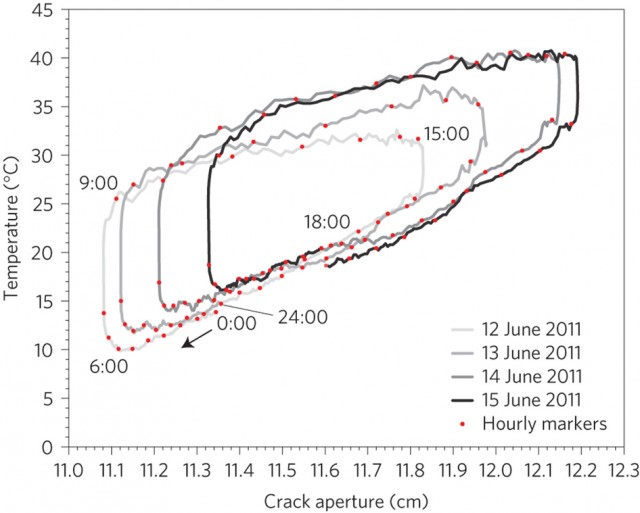30 March 2016
Rockfall triggering on warm days in exfoliating landscapes
Posted by Dave Petley
Rockfall triggering on warm days in exfoliating landscapes
Rockfall triggering is a complex process. It is an interesting intellectual problem with which to grapple – what causes a block to detach at a specific moment in time? Whilst the obvious suspects are of course water and wind; a less blatant factor is the growth of ice within a fracture or joint that can slowly widen the crack until detachment occurs. And of course we know earthquakes are a key issue in those areas that are seismically active, but in many ways that is a different problem.
In the literature there are some suggestions that heating from the sun might also be a factor in landscapes subject to exfoliation. For those who need a reminder, exfoliation occurs when the stress system allows joints to form that run parallel to the rock surface, allowing sheets or slabs of rock to detach. There is a good explanation of this process on the Geological Society webpage, although in my view this overplays the role of chemical weathering. However, the evidence for the strength of this thermally-driven process is not good, so its importance has been hard to judge.
Yosemite is a landscape dominated by exfoliation, creating spectacular landscapes and frequent, potentially hazardous, rockfalls. As such this is an ideal place to study thermally-driven crack widening in an exfoliating landscape. In a paper just published by Nature Geoscience, Brian Collins and Greg Stock (Collins and Stock 2016) have investigated this process by monitoring, over a period in excess of three years, the displacement of a crack forming a large exfoliation joint in Yosemite. This is excellent work using high precision crack meters, and sensors for other environmental conditions, shown below in a figure from the paper:

The exfoliation joint monitored for rockfall triggering – image from Collins and Stock (2016)
.
The results are fascinating. Collins and Stock (2016) show clearly that there is a strong daily cycle of temperature variation on the exfoliation surface as the block is heated by the sun. In response, the crack widens, before narrowing again as the rock block cools back down:

Rockfall triggering by thermal expanision – permanent deformation in the crack induced by heating and cooling – figure from Collins and Stock (2016)
.
But the most exciting element of this is that a component of the deformation is permanent – i.e. at the end of each cycle (each loop in the figure above) the crack is a little wider. In fact the amount of permanent deformation in each cycle shown above is remarkably high – in the order of a millimetre on each occasion. This level of permanent damage will only occur under ideal situations – i.e. in the middle of summer (note the date above in relation to the solar cycle) on a near cloudless day, but nonetheless the role of solar heating in causing permanent displacements in exfoliating landscapes is clear. It is also worth noting the magnitude of the daily displacements, which are in the order of a centimentre. This is a remarkably dynamic environment.
These results are scientifically wonderful, and they have implications for landscape evolution and rockfall hazards in other high mountain areas. Whilst higher than expected levels of rockfalls have been observed in the summer months in many mountain landscapes, in general I think it has been assumed that this is mostly associated with the melting of ice in cracks. Whilst this ice driven process is undoubtedly still important, Collins and Stock (2016) has given us cause to think about other processes too.
Reference
Collins, B.D and Stock, G.M. Rockfall triggering by cyclic thermal stressing of exfoliation fractures. Nature Geoscience. http://dx.doi.org/10.1038/ngeo2686


 Dave Petley is the Vice-Chancellor of the University of Hull in the United Kingdom. His blog provides commentary and analysis of landslide events occurring worldwide, including the landslides themselves, latest research, and conferences and meetings.
Dave Petley is the Vice-Chancellor of the University of Hull in the United Kingdom. His blog provides commentary and analysis of landslide events occurring worldwide, including the landslides themselves, latest research, and conferences and meetings.
This is a very interesting topic. In a similar work by Hatzor & Bakun – Mazor (2013) there is a paper on rockfall triggering due to cycles of seasonal heating and cooling of the jointed rock mass. Their contribution in this phenomenon is equally important and offers an additional explanation of rockfall triggering mechanisms in warm – desert climates.
http://geotechpedia.com/Publication/Show/3836/THERMALLY-VS–SEISMICALLY-INDUCED-BLOCK-DISPLACEMENTS-IN-JOINTED-ROCK-SLOPES-
Missy Eppes (UNC Charlotte) and colleagues have been working for awhile on quantifying the long-underappreciated effects of diurnal heating on rock fracture (e.g., http://www.geosci-instrum-method-data-syst.net/2/275/2013/gi-2-275-2013.pdf). It’s also worth noting that Missy has been working with Greg Stock to investigate the dramatic exfoliation fracturing that occurred in Twain Harte, just north of Yosemite, a few summers ago (https://www.youtube.com/watch?v=yAZ1V_DJKV8f)